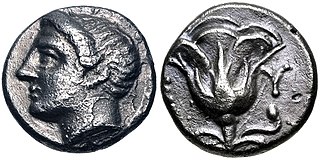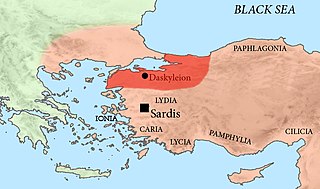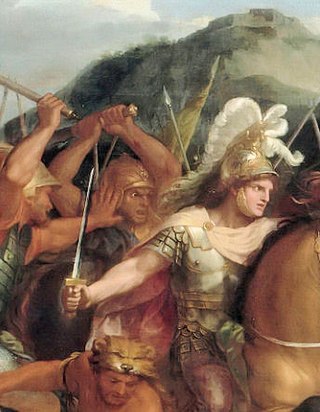
Year 334 BC was a year of the pre-Julian Roman calendar. At the time, it was known as the Year of the Consulship of Caudinus and Calvinus. The denomination 334 BC for this year has been used since the early medieval period, when the Anno Domini calendar era became the prevalent method in Europe for naming years.

The Battle of Issus occurred in southern Anatolia, on 5 November 333 BC between the Hellenic League led by Alexander the Great and the Achaemenid Empire, led by Darius III. It was the second great battle of Alexander's conquest of Asia, and the first encounter between Darius III and Alexander the Great. The battle resulted in the Macedonian troops defeating the Persian forces.

The wars of Alexander the Great were a series of conquests that were carried out by Alexander III of Macedon from 336 BC to 323 BC. They began with battles against the Achaemenid Persian Empire, then under the rule of Darius III of Persia. After Alexander's chain of victories against Achaemenid Persia, he began a campaign against local chieftains and warlords that stretched as far from Greece as the region of Punjab in South Asia. At the time of his death, he ruled over most regions of Greece and the conquered Achaemenid Empire ; he did not, however, manage to conquer the Indian subcontinent in its entirety according to his initial plan. Despite his military accomplishments, Alexander did not provide any stable alternative to the rule of the Achaemenid Empire, and his untimely death threw the vast territories he conquered into a series of civil wars, commonly known as the Wars of the Diadochi.

The Battle of the Granicus in May 334 BC was the first of three major battles fought between Alexander the Great of Macedon and the Persian Achaemenid Empire. The battle took place on the road from Abydus to Dascylium, at the crossing of the Granicus in the Troad region, which is now called the Biga River in Turkey. In the battle Alexander defeated the field army of the Persian satraps of Asia Minor, which defended the river crossing. After this battle, the Persians were forced on the defensive in the cities that remained under their control in the region.

Memnon of Rhodes was a prominent Rhodian Greek commander in the service of the Achaemenid Empire. Related to the Persian aristocracy by the marriage of his sister to the satrap Artabazus II, together with his brother Mentor he served the Persian king for most of his life, and played an important role during the invasion of Alexander the Great and the decades before that.
Parmenion, son of Philotas, was a Macedonian general in the service of Philip II of Macedon and Alexander the Great. A nobleman, Parmenion rose to become Philip's chief military lieutenant and Alexander's strategos. He was assassinated after his son Philotas was convicted on a charge of treason. His siblings Asander and Agathon would also become prominent members of Alexander's Macedonia.

Autophradates was a Persian Satrap of Lydia, who also distinguished himself as a general in the reign of Artaxerxes III and Darius III.

Cleitus the Black was an officer of the Macedonian army led by Alexander the Great. He saved Alexander's life at the Battle of the Granicus in 334 BC and was killed by him in a drunken quarrel six years later. Cleitus was the son of Dropidas and brother of Alexander's nurse, Lanike. He would be given the epithet 'the Black' to distinguish him from Cleitus the White.

Calas or Callas was an ancient Greek, son of Harpalus of Elimiotis and first cousin to Antigonus, king of Asia.

Asander or Asandros was the son of Philotas and brother of Parmenion and Agathon. He was a Macedonian general under Alexander the Great, and satrap of Lydia from 334 BC as well as satrap of Caria after Alexander's death. During Alexander's reign Asander's position suffered for a period following Parmenion's execution, he was sent to Media to gather reinforcements during this time, and a year later was sent to Bactra.

Spithridates was a Persian satrap of Lydia and Ionia under the high king Darius III Codomannus. He was one of the Persian commanders at the Battle of the Granicus, in 334 BC. In this engagement, while he was aiming a blow from behind at Alexander the Great, his arm was cut off by Cleitus the Black and he subsequently died.

Philip, son of Machatas and brother of Harpalus, was an officer in the service of Alexander the Great, who in 327 BC was appointed by Alexander as satrap of India, including the provinces westward of the Hydaspes, as far south as the junction of the Indus with the Acesines. After the conquest of the Malli (Malwa) and Oxydracae, these tribes also were added to his government.

Artabazos II was a Persian general and satrap of Hellespontine Phrygia. He was the son of the Persian satrap of Hellespontine Phrygia Pharnabazus II, and younger kinsman of Ariobarzanes of Phrygia who revolted against Artaxerxes II around 356 BC. His first wife was an unnamed Greek woman from Rhodes, sister of the two mercenaries Mentor of Rhodes and Memnon of Rhodes. Towards the end of his life, he became satrap of Bactria for Alexander the Great.
Pharnabazus III was a Persian satrap who fought against Alexander the Great. His father was Artabazos II, and his mother a Greek from Rhodes.
Ptolemy, son of Philip was an officer who commanded the leading squadron of Macedonian cavalry at the Battle of the Granicus. Both Gronovius and Droysen, suppose that he is the same man that Alexander left with a force of 3,000 infantry and 200 cavalry to defend the province of Caria, and who subsequently, together with Asander the governor of Lydia, defeated the Persian general Orontobates, 332 BC.
Arsames was an Achaemenid Persian satrap of Cilicia in 334/3 BC. He succeeded Mazaeus in this position. He took part in the Battle of Granicus where he fought with his cavalry on the left wing, along with Arsites and Memnon of Rhodes. He was able to survive that battle and flee to the capital of Cilicia Tarsus. There he was planning a scorched-earth policy according to that of Memnon which caused the native Cilician soldiers to abandon their posts. He also decided to burn Tarsus to the ground so as not to fall in the hands of Alexander but was prevented from doing so by the speedy arrival of Parmenion with the light armored units who took the city. After that, Arsames fled to Darius who was at this time in Syria. He was slain at the battle of Issus in 333 BC.
Niphates was one of the Persian generals in the Battle of the Granicus in 334 BC in Asia Minor. He was stationed on the Persian right during the battle formation, along with Rheomithres and Petenes, and faced the Thessalians, which according to Arrian did heavy damage to the Persians. The scarcity of the details regarding his participation is attributed to the focus of the available sources on Alexander the Great, who fought the Lydians, Rhoesaces and Spithridates in the center. An earlier timeline, put him in a council with other Persian generals and the Persian cavalry near the city of Zeleia. Niphates was killed during the battle at Granicus.
Rheomithres was a Persian noble. He was father of several children, including Phrasaortes whom Alexander the Great appointed satrap of Persis in 330 BC. He joined in the Great Satraps' Revolt of the western Persian provinces from Artaxerxes II, in 362 BC, and was employed by his confederates to go to Tachos, pharaoh of Egypt, for aid. He came back with 500 talents and 50 warships and he is supposed to have left his wife and his children to Tachos as a guarantee for his assistance. Nevertheless, Rheomithres betrayed the rebels and he invited a number of them in a meeting. On their arrival, he arrested them, and despatched them in chains to Artaxerxes to receive the bounties, thus making his own peace at court. Rheomithres took part in the battle of the Granicus, in 334 BC, where he was in command of a body of 2,000 cavalry on the right wing, between 1,000 Medes and 2,000 Bactrians. He survived the battle and the next year he joined Darius at the battle of Issus, where he lost his life.
Atizyes was a Persian satrap of Greater Phrygia under the Achaemenids in 334 BC, when Alexander the Great began his campaign. He is not mentioned in the council of Zelea where the satrap coalition was formed against the invasion, so it is not sure whether he took part in the battle of the Granicus. After the battle, he appears to be in the capital of Greater Phrygia, Celaenae where he had a garrison force of 1,000 Carians and 100 Greek mercenaries. He himself went to Syria to join the army of Darius III and fell in the battle of Issus at 333 BC. After Phrygia fell to Alexander, he appointed his general Antigonus Monophthalmus as its satrap.
Petenes was one of the Persian generals in the Battle of the Granicus in 334 BC in Asia Minor. He was killed during the cavalry engagement.














